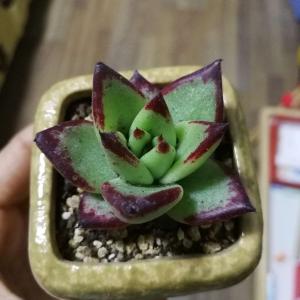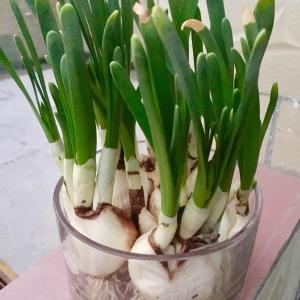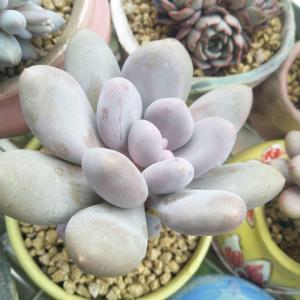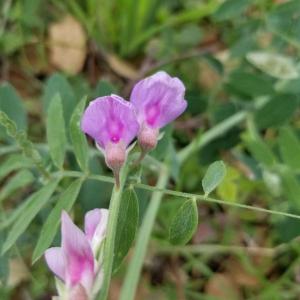文章
Miss Chen
2018年02月28日

Description: This herbaceous perennial plant is up to 2½' tall, forming occasional lateral stems. These stems are light green, hairless, and rather shiny. The shiny compound leaves are medium green, hairless, and odd-pinnate with 3 or 5 leaflets. The lower compound leaves have long petioles, which become shorter as the leaves alternate upward along the stems. The variable leaflets are up to 3" long and 2" across; they are lanceolate, ovate, cordate, or broadly oblong in shape, although the larger leaflets sometimes have 1-2 cleft lobes. Leaflet margins are serrated.
Compound Umbel
Flat to slightly rounded compound umbels of yellow flowers occur at the ends of the upper stems. Each compound umbel is about 2-3" across, and consists of about 12 umbellets. There are about 21 flowers in each umbellet; the central flower of each umbellet is sessile (or nearly so) during the blooming period. Each flower is about 1/8" (3 mm.) across; it has 5 incurved yellow petals, an insignificant calyx, a pistil, and 5 stamens. The blooming period occurs from late spring to early summer, and lasts about 1 month. There is no floral scent. The seeds are oblong and flattened, but not winged, with several lighter-colored longitudinal ridges. The root system consists of a dense cluster of coarse fibrous roots.
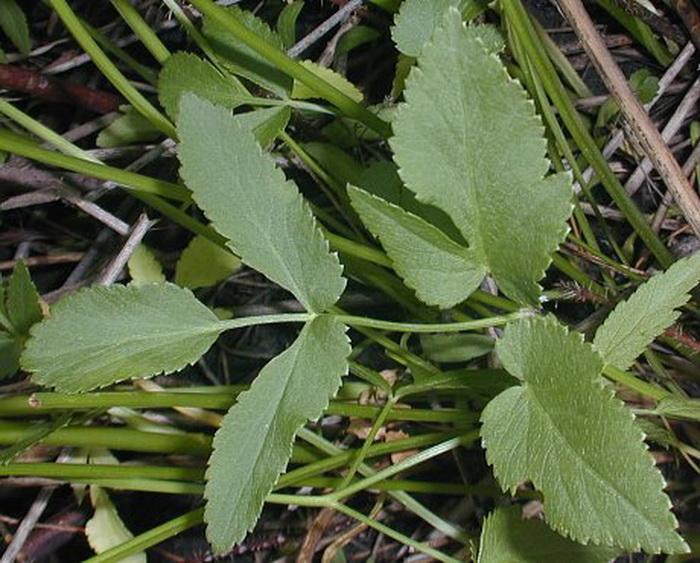
Cultivation: The preference is full to partial sun, although light shade under trees is tolerated. The soil should be moist and loamy, and can contain some rocky material. Foliar disease rarely occurs. The seeds can be difficult to germinate, otherwise this plant is easy to grow and maintain.
Range & Habitat: The native Golden Alexanders is occasional to locally common in most areas of Illinois, except for some southern and western counties, where it is uncommon or absent (see Distribution Map). Habitats include moist black soil prairies, openings in moist to mesic woodlands, areas along woodland paths, savannas, thickets, limestone glades, thinly wooded bluffs, powerline clearances in wooded areas, and abandoned fields. Golden Alexanders occurs in both degraded and higher quality habitats. It adapts readily to habitat restorations.
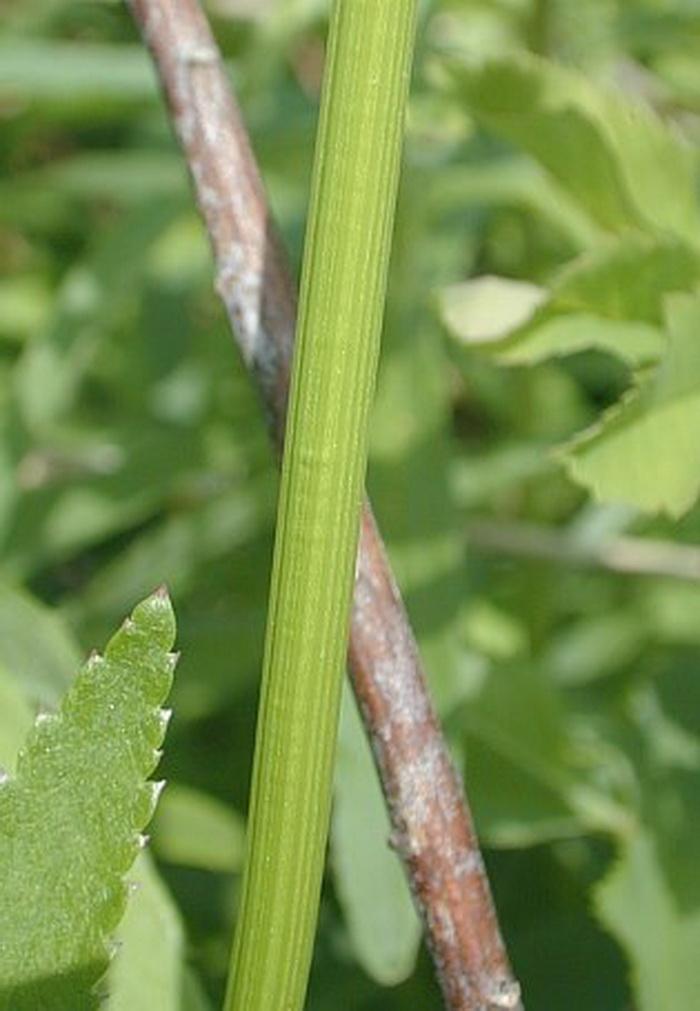
Faunal Associations: The flowers are attractive to many kinds of insects seeking pollen or nectar, especially short-tongued bees, wasps, flies, and beetles. Among the short-tongued bees are such visitors as Green Metallic bees, Masked bees, and Andrenid bees (including the oligolege, Andrena ziziae). Wasp visitors include Eumenine wasps, spider wasps, Ichneumonid wasps, and Crabronine wasps. Such long-tongued bees as bumblebees, cuckoo bees (Nomada spp.) also visit the flowers, as do some small butterflies and true bugs. Notwithstanding all of these visitors, this plant is capable of self-pollination. Caterpillars of the butterflies Papilio polyxenes asterius (Black Swallowtail) and Papilio joanae (Ozark Swallowtail) feed on the leaves and flowers, while caterpillars of Papaipema rigida (Rigid Sunflower Borer Moth) bore through the stems. Two aphids, Aphis saniculae and Aphis thaspii, suck plant juices from Golden Alexanders and similar species in the Carrot family.
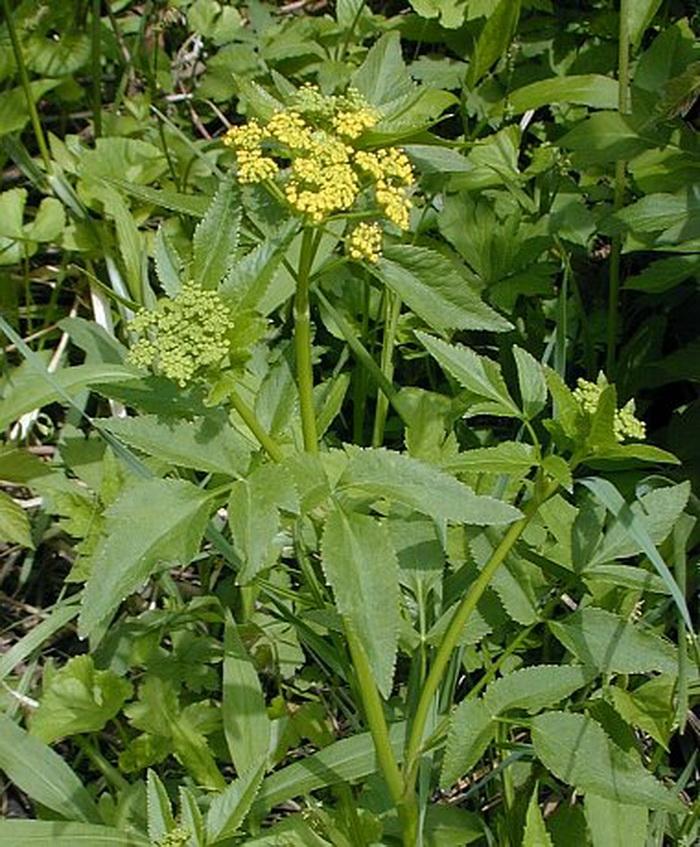
Photographic Location: The photographs were taken at Busey Woods in Urbana, Illinois.
Comments: Golden Alexanders should not be confused with Pastinaca sativa (Wild Parsnip), which is a weedy Eurasian biennial. The latter is taller, blooms later, and has more leaflets in each compound leaf. It can be particularly difficult to distinguish Golden Alexanders from Thaspium trifoliatum aureum (Yellow Meadow Parsnip), which is another native perennial plant. For the latter plant, the central flower of each umbellet has a short pedicel, the achenes are winged, and its basal leaves are simple, rather than trifoliate. Otherwise, these two species share nearly the same characteristics. Golden Alexanders is an excellent addition to a wildflower garden because it provides accessible nectar to many beneficial insects with short mouthparts during the spring and early summer when such flowers are relatively uncommon.
Compound Umbel
Flat to slightly rounded compound umbels of yellow flowers occur at the ends of the upper stems. Each compound umbel is about 2-3" across, and consists of about 12 umbellets. There are about 21 flowers in each umbellet; the central flower of each umbellet is sessile (or nearly so) during the blooming period. Each flower is about 1/8" (3 mm.) across; it has 5 incurved yellow petals, an insignificant calyx, a pistil, and 5 stamens. The blooming period occurs from late spring to early summer, and lasts about 1 month. There is no floral scent. The seeds are oblong and flattened, but not winged, with several lighter-colored longitudinal ridges. The root system consists of a dense cluster of coarse fibrous roots.

Cultivation: The preference is full to partial sun, although light shade under trees is tolerated. The soil should be moist and loamy, and can contain some rocky material. Foliar disease rarely occurs. The seeds can be difficult to germinate, otherwise this plant is easy to grow and maintain.
Range & Habitat: The native Golden Alexanders is occasional to locally common in most areas of Illinois, except for some southern and western counties, where it is uncommon or absent (see Distribution Map). Habitats include moist black soil prairies, openings in moist to mesic woodlands, areas along woodland paths, savannas, thickets, limestone glades, thinly wooded bluffs, powerline clearances in wooded areas, and abandoned fields. Golden Alexanders occurs in both degraded and higher quality habitats. It adapts readily to habitat restorations.

Faunal Associations: The flowers are attractive to many kinds of insects seeking pollen or nectar, especially short-tongued bees, wasps, flies, and beetles. Among the short-tongued bees are such visitors as Green Metallic bees, Masked bees, and Andrenid bees (including the oligolege, Andrena ziziae). Wasp visitors include Eumenine wasps, spider wasps, Ichneumonid wasps, and Crabronine wasps. Such long-tongued bees as bumblebees, cuckoo bees (Nomada spp.) also visit the flowers, as do some small butterflies and true bugs. Notwithstanding all of these visitors, this plant is capable of self-pollination. Caterpillars of the butterflies Papilio polyxenes asterius (Black Swallowtail) and Papilio joanae (Ozark Swallowtail) feed on the leaves and flowers, while caterpillars of Papaipema rigida (Rigid Sunflower Borer Moth) bore through the stems. Two aphids, Aphis saniculae and Aphis thaspii, suck plant juices from Golden Alexanders and similar species in the Carrot family.

Photographic Location: The photographs were taken at Busey Woods in Urbana, Illinois.
Comments: Golden Alexanders should not be confused with Pastinaca sativa (Wild Parsnip), which is a weedy Eurasian biennial. The latter is taller, blooms later, and has more leaflets in each compound leaf. It can be particularly difficult to distinguish Golden Alexanders from Thaspium trifoliatum aureum (Yellow Meadow Parsnip), which is another native perennial plant. For the latter plant, the central flower of each umbellet has a short pedicel, the achenes are winged, and its basal leaves are simple, rather than trifoliate. Otherwise, these two species share nearly the same characteristics. Golden Alexanders is an excellent addition to a wildflower garden because it provides accessible nectar to many beneficial insects with short mouthparts during the spring and early summer when such flowers are relatively uncommon.
0
0
文章
Miss Chen
2018年02月27日

Description: This perennial plant is 3-6" tall. The individual leaves and flowering stems emerge directly from the rootstock. Each leaf is deeply divided into 3-5 palmate lobes, while a lobe may be further subdivided into 2-3 smaller lobes. The lobes are usually broader toward their tips than at the base of the leaf, and their tips may have 1 or 2 small teeth. A typical leaf is about 1" long and across (excluding the petiole). The petiole of each leaf is rather long and slender. The slender flowering stems are at least as long as the petioles; they are either green or purple. Each stem curves abruptly downward near the flower. The entire plant is hairless, or nearly so. The flowers have 5 petals and 5 sepals; they are ¾–1½" across. The sepals are green, while the petals are pale blue-violet to dark purple-violet. Usually the petals are the same color, although sometimes the upper two petals are dark purple-violet, while the lower three petals are pale blue-violet. Toward the throat of the flower, the lower petal is white with fine violet lines that function as nectar guides. There are no white hairs near the throat. The stamens are a conspicuous golden yellow.
The blooming period is mid- to late spring, and this plant may bloom during the fall. There may be a mild floral scent in some local ecotypes. Unlike other violets, Birdfoot Violet does not produce cleistogamous flowers. The coppery seeds can be ejected several inches from the mother plant. There is a sugary gel on the seeds that attracts ants; these ants often carry these seeds to their nests. The root system consists of a tuberous caudex with long coarse roots. Sometimes rhizomes are produced, forming vegetative offsets.
Cultivation: The preference is full sun and dry conditions. However, a little shade and more moisture is tolerated, if the site is well-drained. The soil should be sandy or rocky to reduce competition from other plants; a somewhat acid pH is preferred. The greatest danger is crown rot from poorly drained, heavy soil. This plant is more difficult to grow than most.

Range & Habitat: The native Birdfoot Violet occurs occasionally in northern Illinois and in counties along the Mississippi River, but it is uncommon or absent elsewhere (see Distribution Map). Habitats include upland areas of black soil prairies, sand prairies, hill prairies, sandstone glades, cherty slopes, thinly wooded bluffs, openings in rocky or sandy forests, sandy Black Oak savannas, and sand dunes near Lake Michigan. This plant is largely restricted to high quality habitats. Fire is a beneficial management tool in areas with trees and shrubs.
Faunal Associations: The flowers attract long-tongued bees, small butterflies, and skippers. Bee visitors during the spring include bumblebees and Anthophorine bees. Compared to other violets, the flowers of this species attracts more butterflies and skippers, which are often held horizontal to the ground (face up) and easier for such insects to land on. The caterpillars of various Fritillary butterflies feed on the foliage and flowers; the caterpillars of Speyeria idalia (Regal Fritillary) may prefer this violet species over others as a food source. As noted above, ants are attracted to the sugary gel on the seeds, and help to distribute them.

Photographic Location: The photograph of the plant with bicolored flowers was taken at a thinly wooded bluff near Kickapoo State Park in Vermilion County, Illinois. The photograph of the plant with pale blue-violet flowers was taken at a sandy savanna in Kankakee County, Illinois. The photograph of the plant with with violet flowers was taken on a sandy wooded hillside at the Indiana Dunes State Park in NW Indiana.
Comments: The photographs show three different color-forms of Birdfoot Violet and they are all beautiful. This violet can be distinguished from other Viola spp. (Violets) by its deeply lobed leaves, the large size of its flowers, and the absence of hairs near the throat of each flower. The common name refers to the appearance of the leaves.
The blooming period is mid- to late spring, and this plant may bloom during the fall. There may be a mild floral scent in some local ecotypes. Unlike other violets, Birdfoot Violet does not produce cleistogamous flowers. The coppery seeds can be ejected several inches from the mother plant. There is a sugary gel on the seeds that attracts ants; these ants often carry these seeds to their nests. The root system consists of a tuberous caudex with long coarse roots. Sometimes rhizomes are produced, forming vegetative offsets.
Cultivation: The preference is full sun and dry conditions. However, a little shade and more moisture is tolerated, if the site is well-drained. The soil should be sandy or rocky to reduce competition from other plants; a somewhat acid pH is preferred. The greatest danger is crown rot from poorly drained, heavy soil. This plant is more difficult to grow than most.

Range & Habitat: The native Birdfoot Violet occurs occasionally in northern Illinois and in counties along the Mississippi River, but it is uncommon or absent elsewhere (see Distribution Map). Habitats include upland areas of black soil prairies, sand prairies, hill prairies, sandstone glades, cherty slopes, thinly wooded bluffs, openings in rocky or sandy forests, sandy Black Oak savannas, and sand dunes near Lake Michigan. This plant is largely restricted to high quality habitats. Fire is a beneficial management tool in areas with trees and shrubs.
Faunal Associations: The flowers attract long-tongued bees, small butterflies, and skippers. Bee visitors during the spring include bumblebees and Anthophorine bees. Compared to other violets, the flowers of this species attracts more butterflies and skippers, which are often held horizontal to the ground (face up) and easier for such insects to land on. The caterpillars of various Fritillary butterflies feed on the foliage and flowers; the caterpillars of Speyeria idalia (Regal Fritillary) may prefer this violet species over others as a food source. As noted above, ants are attracted to the sugary gel on the seeds, and help to distribute them.

Photographic Location: The photograph of the plant with bicolored flowers was taken at a thinly wooded bluff near Kickapoo State Park in Vermilion County, Illinois. The photograph of the plant with pale blue-violet flowers was taken at a sandy savanna in Kankakee County, Illinois. The photograph of the plant with with violet flowers was taken on a sandy wooded hillside at the Indiana Dunes State Park in NW Indiana.
Comments: The photographs show three different color-forms of Birdfoot Violet and they are all beautiful. This violet can be distinguished from other Viola spp. (Violets) by its deeply lobed leaves, the large size of its flowers, and the absence of hairs near the throat of each flower. The common name refers to the appearance of the leaves.
0
0
文章
Miss Chen
2018年02月27日

Description: This perennial plant is up to 5' tall and unbranched, except near the inflorescence. The central stem is round and smooth. Scattered along this stem are 3-7 whorled leaves. These leaves are up to 6" long and 1½" across with serrated margins. They are ovate to narrowly ovate, and are either sessile or have short petioles. At the apex of the plant are several slender spikes of white flowers up to 8" long, resembling a candelabra. The narrow tubular flowers are about ¼" long, from which 2 yellow or brown stamens are exerted. These flowers are crowded together all around each spike, blooming from the bottom up. They have no scent.
The blooming period usually occurs from early to mid-summer, and lasts about a month. The tiny seeds can be carried several feet away from the mother plant by the wind. The root system consists of a central taproot and some rhizomes, which enable vegetative reproduction.
Cultivation: The preference is full or partial sun, and moist to average conditions. Growth is best in rich loamy soil, although some sand or clay is tolerated. The leaves may turn yellowish green in bright sunlight or during a drought, otherwise they normally appear healthy and are not often bothered by disease. This plant has a tendency to flop over on slopes.

Range & Habitat: The native Culver's Root occurs throughout Illinois, except a few south-central counties (see Distribution Map). Although widely distributed, it is only occasionally seen. Culver's root occurs in moist to mesic black soil prairies, sand prairies, openings and edges of woodlands, thickets, savannas, and swampy meadows along rivers and ditches. This plant is not often seen in highly disturbed habitats.
Faunal Associations: The most common visitors to the flowers are long-tongued and short-tongued bees, which collect pollen or suck nectar. This includes honeybees, bumblebees, Mason bees, Green Metallic bees, Masked bees, and others. Other kinds of insect visitors include Sphecid wasps, butterflies, moths, and Syrphid flies. The latter include species that feed on pollen only and are non-pollinating. Culver's Root doesn't appear to be bothered by leaf-chewing insects or mammalian herbivores to the same extent as other plants. The seeds are too tiny to be of much interest to birds.

Photographic Location: The photographs were taken at Meadowbrook Park in Urbana, Illinois.
Comments: While in bloom, this plant has an elegant appearance, although the pretty white flowers rapidly turn brown. Its common name refers to the medicinal usage of the bitter root, which has purgative properties. The surname 'Culver' probably refers to a pioneer physician who advocated the use of this plant for the treatment of various ailments.
The blooming period usually occurs from early to mid-summer, and lasts about a month. The tiny seeds can be carried several feet away from the mother plant by the wind. The root system consists of a central taproot and some rhizomes, which enable vegetative reproduction.
Cultivation: The preference is full or partial sun, and moist to average conditions. Growth is best in rich loamy soil, although some sand or clay is tolerated. The leaves may turn yellowish green in bright sunlight or during a drought, otherwise they normally appear healthy and are not often bothered by disease. This plant has a tendency to flop over on slopes.

Range & Habitat: The native Culver's Root occurs throughout Illinois, except a few south-central counties (see Distribution Map). Although widely distributed, it is only occasionally seen. Culver's root occurs in moist to mesic black soil prairies, sand prairies, openings and edges of woodlands, thickets, savannas, and swampy meadows along rivers and ditches. This plant is not often seen in highly disturbed habitats.
Faunal Associations: The most common visitors to the flowers are long-tongued and short-tongued bees, which collect pollen or suck nectar. This includes honeybees, bumblebees, Mason bees, Green Metallic bees, Masked bees, and others. Other kinds of insect visitors include Sphecid wasps, butterflies, moths, and Syrphid flies. The latter include species that feed on pollen only and are non-pollinating. Culver's Root doesn't appear to be bothered by leaf-chewing insects or mammalian herbivores to the same extent as other plants. The seeds are too tiny to be of much interest to birds.

Photographic Location: The photographs were taken at Meadowbrook Park in Urbana, Illinois.
Comments: While in bloom, this plant has an elegant appearance, although the pretty white flowers rapidly turn brown. Its common name refers to the medicinal usage of the bitter root, which has purgative properties. The surname 'Culver' probably refers to a pioneer physician who advocated the use of this plant for the treatment of various ailments.
0
0
文章
Miss Chen
2018年02月27日

Description: This herbaceous perennial plant is 2-4' tall and unbranched. The central stem is round, hairless, and white, light green, or reddish purple. The alternate leaves are up to 5" long and ½" across. They are narrowly lanceolate, narrowly ovate, or linear. Their margins are serrated, while the upper and lower leaf surfaces are hairless. The lower leaf surface also has a prominent central vein, and black dots may be present. The leaves are sessile against the stem, or they have short petioles. The central stem terminates in a flat-topped cluster of magenta compound flowers (i.e., a corymb). This flower cluster is quite dense, rather than loose and spreading. The flowering stalks may be slightly pubescent.
A compound flower consists of 15-30 disk florets with a short cylinder of green bracts underneath. These bracts are appressed together like fish scales, and they are often slightly ciliate. The cylinder of bracts spans about 1/5" across. A disk floret is magenta, with 5 spreading lobes and a prominent divided style. The blooming period occurs from late summer to early fall, and lasts about a month. There is no noticeable floral scent. The flowers are replaced by achenes that have a pappus of hair-like scales. These achenes can be blown several feet from the mother plant by gusts of wind. The root system is spreading and fibrous.
Cultivation: The preference is full sun, moist conditions, and fertile soil. Partial sun and slightly moister or drier conditions are also tolerated. This plant can withstand occasional flooding for short periods of time. The foliage is not bothered by pests and disease to any significant extent.

Range & Habitat: The native Smooth Ironweed is fairly common in in the northern half of Illinois, but uncommon elsewhere in the state (see Distribution Map). Habitats include wet to moist black soil prairies, riverbottom prairies, marshes, sloughs along railroads, and edges of fields. Smooth Ironweed is found in wetland habitats to a greater extent than other species of Ironweeds.
Faunal Associations: The flowers attract long-tongued bees, butterflies, and skippers primarily. Other visitors include bee flies and Halictid bees. These insects seek nectar, although bees also collect pollen. Among the long-tongued bees, are such visitors as bumblebees, Epeoline cuckoo bees, Miner bees, and large Leaf-Cutting bees. An oligolectic bee of Ironweeds is Melissodes vernoniae. The caterpillars of several moths feed on Ironweed, including Grammia parthenice (Parthenice Tiger Moth) and Perigea xanthioides (Red Groundling). Caterpillars that bore into the roots or stems of Ironweed include Papaipema cerussata (Ironweed Borer Moth), Carmenta bassiformis (Eupatorium Borer Moth), and some Polygrammodes spp. (Pyralid Moths). The bitter foliage of Ironweed deters consumption by mamamalian herbivores – it is known as an 'increaser' because it is one of the last plants to be eaten in overgrazed pastures.

Photographic Location: The photographs were taken of plants growing in a moist prairie along a railroad in Iroquois County, Illinois.
Comments: Another common name for this plant is Common Ironweed. However, in southern Illinois, this species is not common. Smooth Ironweed is one of the smaller Ironweeds with a compact inflorescence and smooth hairless leaves. Other Ironweed species have hairy stems or leaves. An exception is Vernonia gigantea (Tall Ironweed), which has hairless leaves and stems upon occasion. However, Tall Ironweed has a spreading inflorescence, and it is usually a taller plant (as the name implies). The larger leaves of Tall Ironweed exceed ½" across, while the leaves of Smooth Ironweed are ½" or less. Some authorities state that Smooth Ironweed has black dots on the undersides of the leaves, but this is not always true. The species in this genus are occasionally difficult to identify because they can hybridize with each other.
A compound flower consists of 15-30 disk florets with a short cylinder of green bracts underneath. These bracts are appressed together like fish scales, and they are often slightly ciliate. The cylinder of bracts spans about 1/5" across. A disk floret is magenta, with 5 spreading lobes and a prominent divided style. The blooming period occurs from late summer to early fall, and lasts about a month. There is no noticeable floral scent. The flowers are replaced by achenes that have a pappus of hair-like scales. These achenes can be blown several feet from the mother plant by gusts of wind. The root system is spreading and fibrous.
Cultivation: The preference is full sun, moist conditions, and fertile soil. Partial sun and slightly moister or drier conditions are also tolerated. This plant can withstand occasional flooding for short periods of time. The foliage is not bothered by pests and disease to any significant extent.

Range & Habitat: The native Smooth Ironweed is fairly common in in the northern half of Illinois, but uncommon elsewhere in the state (see Distribution Map). Habitats include wet to moist black soil prairies, riverbottom prairies, marshes, sloughs along railroads, and edges of fields. Smooth Ironweed is found in wetland habitats to a greater extent than other species of Ironweeds.
Faunal Associations: The flowers attract long-tongued bees, butterflies, and skippers primarily. Other visitors include bee flies and Halictid bees. These insects seek nectar, although bees also collect pollen. Among the long-tongued bees, are such visitors as bumblebees, Epeoline cuckoo bees, Miner bees, and large Leaf-Cutting bees. An oligolectic bee of Ironweeds is Melissodes vernoniae. The caterpillars of several moths feed on Ironweed, including Grammia parthenice (Parthenice Tiger Moth) and Perigea xanthioides (Red Groundling). Caterpillars that bore into the roots or stems of Ironweed include Papaipema cerussata (Ironweed Borer Moth), Carmenta bassiformis (Eupatorium Borer Moth), and some Polygrammodes spp. (Pyralid Moths). The bitter foliage of Ironweed deters consumption by mamamalian herbivores – it is known as an 'increaser' because it is one of the last plants to be eaten in overgrazed pastures.

Photographic Location: The photographs were taken of plants growing in a moist prairie along a railroad in Iroquois County, Illinois.
Comments: Another common name for this plant is Common Ironweed. However, in southern Illinois, this species is not common. Smooth Ironweed is one of the smaller Ironweeds with a compact inflorescence and smooth hairless leaves. Other Ironweed species have hairy stems or leaves. An exception is Vernonia gigantea (Tall Ironweed), which has hairless leaves and stems upon occasion. However, Tall Ironweed has a spreading inflorescence, and it is usually a taller plant (as the name implies). The larger leaves of Tall Ironweed exceed ½" across, while the leaves of Smooth Ironweed are ½" or less. Some authorities state that Smooth Ironweed has black dots on the undersides of the leaves, but this is not always true. The species in this genus are occasionally difficult to identify because they can hybridize with each other.
0
0
文章
Miss Chen
2018年02月26日

Description: This perennial plant is 2½–5' tall and unbranched, except near the inflorescence at the apex. The stout central stem is covered with fine white hairs that are quite short. It may have some light purple coloration in some areas. The alternate leaves are up to 5" long and 2" across. They are lanceolate or lanceolate-ovate with serrated margins. Their green upper surface is rough-textured, while the lower surface is finely pubescent with some short white hairs on the major veins. The leaves are short-petioled or sessile against the stem. At the apex of the plant is a loose cluster of flowerheads that is more or less flattened on top. Each flowerhead has 15-30 magenta disk florets and no ray florets. At the base of the flowerhead, are numerous green bracts with recurved tips (i.e., they have a tendency to curl outward). A disk floret has 5 narrow lobes that spread outward, and a prominent divided style. The tips of the style often curl back to form a pair of small coils. The blooming period is mid- to late summer, and lasts about a month. There is no floral scent. The disk florets are replaced by bristly achenes that are flat and oblong. The root system is coarsely fibrous and produces rhizomes, which enable the vegetative spread of this plant.
Cultivation: The preference is full or partial sun and mesic to dry conditions. This plant is not particular about soil type; it often grows in soil that contains clay or abundant rocky material. This species of Ironweed is more drought-resistant than other species in the genus. It blooms a little earlier as well.
Range & Habitat: The native Baldwin's Ironweed is an occasional plant in southwest Illinois, and it is rare or absent elsewhere (see Distribution Map). This plant is more common in states that lie southwest of Illinois (e.g., Missouri). Habitats include upland areas of dry prairies, hill prairies, glades, openings in upland forests, thinly wooded rocky slopes, pastures, abandoned fields, areas along railroads, and miscellaneous waste areas.

Faunal Associations: Primarily long-tongued bees, butterflies, and skippers visit the flowers for nectar. Short-tongued bees may collect pollen from the flowers, but they are non-pollinating. Among the bees, are such visitors as bumblebees, Epeoline Cuckoo bees, and Miner bees. Among the butterfly visitors, Swallowtail and Sulfur butterflies are particularly prominent. The caterpillars of some moth species feed on various parts of Ironweed, including Grammia parthenice (Parthenice Tiger Moth), Perigea xanthioides (Red Groundling), and Papaipema cerussata (Ironweed Borer Moth). Mammalian herbivores generally avoid eating the foliage of Ironweed spp. because of its bitter taste. In pastures, Ironweeds tend to increase at the expense of other plants.
Photographic Location: The photographs were taken of a small colony of plants growing in a prairie at Meadowbrook Park in Urbana, Illinois, where this species was undoubtedly introduced.

Comments: Baldwin's Ironweed is one of the less common species of Ironweed in Illinois. It is a sturdy plant that is well-adapted to dry prairies. The most distinctive characteristic of Baldwin's Ironweed is the recurved tips of its involucral bracts; this sets it apart from other Ironweed spp. in Illinois, which have appressed bracts. However, there is a less common variety of Baldwin's Ironweed that also has appressed bracts at the base of the flowerheads. Baldwin's Ironweed can be distinguished from Vernonia missurica (Missouri Ironweed) by counting the number of disk florets in a flowerhead – Baldwin's Ironweed has 15-30 disk florets, while Missouri Ironweed has 30-55 disk florets. With respect to Vernonia gigantea (Tall Ironweed), Baldwin's Ironweed is a stouter plant with broader leaves. Finally, the stems and leaf undersides of Baldwin's Ironweed are pubescent, while Vernonia fasciculata (Smooth Ironweed) is glabrous throughout. Sometimes, different species of Ironweed hybridize with each other, making identification difficult. Another common name for Vernonia baldwinii is Western Ironweed.
Cultivation: The preference is full or partial sun and mesic to dry conditions. This plant is not particular about soil type; it often grows in soil that contains clay or abundant rocky material. This species of Ironweed is more drought-resistant than other species in the genus. It blooms a little earlier as well.
Range & Habitat: The native Baldwin's Ironweed is an occasional plant in southwest Illinois, and it is rare or absent elsewhere (see Distribution Map). This plant is more common in states that lie southwest of Illinois (e.g., Missouri). Habitats include upland areas of dry prairies, hill prairies, glades, openings in upland forests, thinly wooded rocky slopes, pastures, abandoned fields, areas along railroads, and miscellaneous waste areas.

Faunal Associations: Primarily long-tongued bees, butterflies, and skippers visit the flowers for nectar. Short-tongued bees may collect pollen from the flowers, but they are non-pollinating. Among the bees, are such visitors as bumblebees, Epeoline Cuckoo bees, and Miner bees. Among the butterfly visitors, Swallowtail and Sulfur butterflies are particularly prominent. The caterpillars of some moth species feed on various parts of Ironweed, including Grammia parthenice (Parthenice Tiger Moth), Perigea xanthioides (Red Groundling), and Papaipema cerussata (Ironweed Borer Moth). Mammalian herbivores generally avoid eating the foliage of Ironweed spp. because of its bitter taste. In pastures, Ironweeds tend to increase at the expense of other plants.
Photographic Location: The photographs were taken of a small colony of plants growing in a prairie at Meadowbrook Park in Urbana, Illinois, where this species was undoubtedly introduced.

Comments: Baldwin's Ironweed is one of the less common species of Ironweed in Illinois. It is a sturdy plant that is well-adapted to dry prairies. The most distinctive characteristic of Baldwin's Ironweed is the recurved tips of its involucral bracts; this sets it apart from other Ironweed spp. in Illinois, which have appressed bracts. However, there is a less common variety of Baldwin's Ironweed that also has appressed bracts at the base of the flowerheads. Baldwin's Ironweed can be distinguished from Vernonia missurica (Missouri Ironweed) by counting the number of disk florets in a flowerhead – Baldwin's Ironweed has 15-30 disk florets, while Missouri Ironweed has 30-55 disk florets. With respect to Vernonia gigantea (Tall Ironweed), Baldwin's Ironweed is a stouter plant with broader leaves. Finally, the stems and leaf undersides of Baldwin's Ironweed are pubescent, while Vernonia fasciculata (Smooth Ironweed) is glabrous throughout. Sometimes, different species of Ironweed hybridize with each other, making identification difficult. Another common name for Vernonia baldwinii is Western Ironweed.
0
0
文章
Miss Chen
2018年02月26日

Description: This perennial plant is 2½–5' tall and unbranched, except near the apex where the inflorescence occurs. The central stem is light green, terete, slightly short-pubescent, and stiffly erect. Alternate leaves occur along the entire length of the stem; they are ascending to widely spreading. The leaves are 3-6" long and ¼–¾" across; they are linear to linear-elliptic in shape, sessile or short-petiolate, and either entire (toothless) or sparsely and minutely toothed along their margins. The leaves have prominent central veins that are light-colored. The upper leaf surface is medium to dark green and glabrous to rough-textured from minute stiff hairs. The lower leaf surface is light green and glabrous to sparsely short-pubescent, except along central vein, where it is pubescent. The central stem and lateral upper stems terminate in clusters of flowerheads that are somewhat flat-topped. The branches and peduncles of the flowerheads are light green, sparsely short-pubescent, and terete; the peduncles are 1½–5" long.
Flowerheads
Each flowerhead is ¾–1¼" across, consisting of a dense head of 50-100 disk florets and no ray florets. The corollas of the disk florets are magenta (reddish purple), narrowly tubular in shape, and 5-lobed; the corolla lobes of these florets are narrowly lanceolate in shape and ascending. Bifurcated styles are exserted from these corollas; these styles are magenta. Surrounding the base of each flowerhead, there are numerous phyllaries in several series; they are loosely overlapping. Individual phyllaries are ½–1" long; their bases are linear-lanceolate in shape, tapering into long filiform tips that are more or less incurved. These phyllaries are mostly light green, except toward their tips, where they are often white to magenta; they are sparsely short-pubescent. The blooming period occurs from late summer to early autumn, lasting about 1 month for a colony of plants. There is no noticeable floral scent. Afterwards, the florets are replaced by achenes with small tufts of bristly hair at their apices; these hairs are light brown or pale purple. The achenes are 3-5 mm. long and bullet-shaped with vertical pubescent ribs; they are distributed to some extent by the wind. The root system consists of stout short rhizomes, from which clonal offsets are produced.

Cultivation: In Illinois, this plant occurs at sites with full sun, mesic conditions, and a loam or clay-loam soil.
Range & Habitat: Great Ironweed is a very rare plant in Illinois; it has been collected only in Champaign County in the east-central portion of the state during 1957-1958 (see Distribution Map). These specimens are located in the herbarium of the Illinois State Museum. Apparently, the population of plants at the original collection site was destroyed and the species was thought to be extirpated from the state. However, during the late summer of 2005 the webmaster discovered several plants of Great Ironweed at Meadowbrook Park in Urbana, Illinois (also in Champaign County). The status of this ironweed as a native or adventive species in Illinois is uncertain. Habitats of this rare species in Champaign County include roadside fencerows and prairies. Great Ironweed is more common in areas that lie to the southwest of Illinois (e.g., Missouri and Arkansas). It is often found in rocky glades in these areas.

Faunal Associations: The flowerheads of ironweeds (Vernonia spp.) attract bumblebees, little carpenter bees (Ceratina spp.), cuckoo bees (Triepeolus spp.), digger bees (Melissodes spp., Svastra spp.), leaf-cutting bees (Megachile spp.), Halictid bees (including green metallic bees), bee flies (Bombyliidae), butterflies (Papilio spp. & others), and skippers (Polites spp. & others); see Robertson (1929) and Reed (1993). The bee visitors are attracted to the nectar and pollen of the flowerheads, while the remaining insects feed on the nectar. Two digger bees, Melissodes vernoniae and Melissodes denticulata, are specialist pollinators (oligoleges) of ironweeds. Other insects feed on the leaves, bore through the stems or roots, suck plant juices, or feed destructively on the flowerheads of these plants. Examples of such insects include the Thirteen-spotted Billbug (Rhodobaenus tredecimpunctatus), larvae of the Ironweed Bud Midge (Asphondylia vernoniae), larvae of the Ironweed Blossum Midge (Youngomyia podophyllae), larvae of the Ironweed Borer Moth (Papaipema cerussata), larvae of the Parthenice Tiger Moth (Grammia parthenice), the Ironweed Aphid (Aphis vernoniae), Four-humped Stink Bug (Brochymena quadripustulata), Little Pasture Grasshopper (Melanoplus confusus), Four-spotted Tree Cricket (Oecanthus quadripunctatus), and Short-winged Meadow Katydid (Conocephalus brevipennis). The Insect Table provides a more complete list of insects that feed on ironweeds. Vertebrate animals appear to have little use for these plants, as their seeds are little-used by birds and their bitter foliage is usually avoided by mammalian herbivores.

Photographic Location: A prairie at Meadowbrook Park in Urbana, Illinois, where a population of this ironweed has persisted for several years.
Comments: This is one of the easier ironweeds (Vernonia spp.) to identify because of the distinctive appearance of the phyllaries (floral bracts) – long and thread-like. No other ironweed has this kind of phyllary at the base of its flowerheads. Great Ironweed (Vernonia arkansana) also differs from other ironweeds by its narrow leaves and the large number of disk florets (50-100) in each flowerhead. Other species in this genus have flowerheads with fewer disk florets (20-50) and their flowerheads are less wide. Other common names of Vernonia arkansana that are occasionally used include 'Ozark Ironweed' and 'Curlytop Ironweed.' An alternative scientific name for this species is Vernonia crinita. I am happy to see this wonderful wildflower back in the state again.
Flowerheads
Each flowerhead is ¾–1¼" across, consisting of a dense head of 50-100 disk florets and no ray florets. The corollas of the disk florets are magenta (reddish purple), narrowly tubular in shape, and 5-lobed; the corolla lobes of these florets are narrowly lanceolate in shape and ascending. Bifurcated styles are exserted from these corollas; these styles are magenta. Surrounding the base of each flowerhead, there are numerous phyllaries in several series; they are loosely overlapping. Individual phyllaries are ½–1" long; their bases are linear-lanceolate in shape, tapering into long filiform tips that are more or less incurved. These phyllaries are mostly light green, except toward their tips, where they are often white to magenta; they are sparsely short-pubescent. The blooming period occurs from late summer to early autumn, lasting about 1 month for a colony of plants. There is no noticeable floral scent. Afterwards, the florets are replaced by achenes with small tufts of bristly hair at their apices; these hairs are light brown or pale purple. The achenes are 3-5 mm. long and bullet-shaped with vertical pubescent ribs; they are distributed to some extent by the wind. The root system consists of stout short rhizomes, from which clonal offsets are produced.

Cultivation: In Illinois, this plant occurs at sites with full sun, mesic conditions, and a loam or clay-loam soil.
Range & Habitat: Great Ironweed is a very rare plant in Illinois; it has been collected only in Champaign County in the east-central portion of the state during 1957-1958 (see Distribution Map). These specimens are located in the herbarium of the Illinois State Museum. Apparently, the population of plants at the original collection site was destroyed and the species was thought to be extirpated from the state. However, during the late summer of 2005 the webmaster discovered several plants of Great Ironweed at Meadowbrook Park in Urbana, Illinois (also in Champaign County). The status of this ironweed as a native or adventive species in Illinois is uncertain. Habitats of this rare species in Champaign County include roadside fencerows and prairies. Great Ironweed is more common in areas that lie to the southwest of Illinois (e.g., Missouri and Arkansas). It is often found in rocky glades in these areas.

Faunal Associations: The flowerheads of ironweeds (Vernonia spp.) attract bumblebees, little carpenter bees (Ceratina spp.), cuckoo bees (Triepeolus spp.), digger bees (Melissodes spp., Svastra spp.), leaf-cutting bees (Megachile spp.), Halictid bees (including green metallic bees), bee flies (Bombyliidae), butterflies (Papilio spp. & others), and skippers (Polites spp. & others); see Robertson (1929) and Reed (1993). The bee visitors are attracted to the nectar and pollen of the flowerheads, while the remaining insects feed on the nectar. Two digger bees, Melissodes vernoniae and Melissodes denticulata, are specialist pollinators (oligoleges) of ironweeds. Other insects feed on the leaves, bore through the stems or roots, suck plant juices, or feed destructively on the flowerheads of these plants. Examples of such insects include the Thirteen-spotted Billbug (Rhodobaenus tredecimpunctatus), larvae of the Ironweed Bud Midge (Asphondylia vernoniae), larvae of the Ironweed Blossum Midge (Youngomyia podophyllae), larvae of the Ironweed Borer Moth (Papaipema cerussata), larvae of the Parthenice Tiger Moth (Grammia parthenice), the Ironweed Aphid (Aphis vernoniae), Four-humped Stink Bug (Brochymena quadripustulata), Little Pasture Grasshopper (Melanoplus confusus), Four-spotted Tree Cricket (Oecanthus quadripunctatus), and Short-winged Meadow Katydid (Conocephalus brevipennis). The Insect Table provides a more complete list of insects that feed on ironweeds. Vertebrate animals appear to have little use for these plants, as their seeds are little-used by birds and their bitter foliage is usually avoided by mammalian herbivores.

Photographic Location: A prairie at Meadowbrook Park in Urbana, Illinois, where a population of this ironweed has persisted for several years.
Comments: This is one of the easier ironweeds (Vernonia spp.) to identify because of the distinctive appearance of the phyllaries (floral bracts) – long and thread-like. No other ironweed has this kind of phyllary at the base of its flowerheads. Great Ironweed (Vernonia arkansana) also differs from other ironweeds by its narrow leaves and the large number of disk florets (50-100) in each flowerhead. Other species in this genus have flowerheads with fewer disk florets (20-50) and their flowerheads are less wide. Other common names of Vernonia arkansana that are occasionally used include 'Ozark Ironweed' and 'Curlytop Ironweed.' An alternative scientific name for this species is Vernonia crinita. I am happy to see this wonderful wildflower back in the state again.
0
0
文章
Miss Chen
2018年02月26日

Description: This perennial plant is unbranched and about 3-4' tall. The central stem is winged, with a slight scattering of small white hairs on the ridges. The alternate leaves are about 5" long and 2" wide, lanceolate to ovate in shape, rather soft in texture, and covered with small white hairs. This gives the leaves a fuzzy light green appearance, especially on their undersides.

The inflorescence at the apex of the plant has several daisy-like composite flowers on rather short pedicels with abundant long white hairs. These composite flowers are bright yellow, about 2–2½" across, and become rather ragged in appearance after they pass their prime. Each flower has 6-12 ray florets, which spread outward horizontally from the central cone (roughly), rather than drooping. The disk florets present a pincushion-like appearance, with each disk floret projecting outward and visibly separated from the others. The blooming period is early to mid-summer, and lasts about a month. There is no noticeable scent to the flowers. This plant often forms colonies from its rhizomes.
Cultivation: The preference is full to partial sun, and mesic conditions. During a drought this plant sometimes wilts, but recovers readily after significant rainfall. This plant often flourishes in soil that is loamy, and will tolerate some clay or stones. The foliage is rarely bothered by disease.Close-up of Leaves
Range & Habitat: The native Yellow Crownbeard occurs occasionally in the southern 3/5 of Illinois, from Peoria to Champaign-Urbana, and southward. It is apparently absent elsewhere (see Distribution Map). It occurs in mesic black soil prairies, rocky upland forests, savannas, thickets, limestone glades, and along railroads. It is especially likely to be observed along railroad prairies.
Faunal Associations: Primarily long-tongued bees visit the flowers for pollen or nectar. These include bumblebees, honeybees, large Leaf-Cutting bees, Little Carpenter bees, and various Cuckoo bees. Other visitors include Halictine bees, Dagger bees, and Thread-Waisted wasps. The caterpillars of the butterfly Chlosyne nycteis (Silvery Checkerspot) and Basilodes pepita (Gold Moth) feed on the foliage.
Photographic Location: The photographs were taken at the Red Bison Railroad Prairie in Savoy, Illinois.
Comments: This is an attractive plant because of the fuzzy leaves; the composite flowers are an additional bonus. Yellow Crownbeard, along with other members of the genus, has been oddly neglected in many prairie field guides, even though it clearly occurs in tallgrass prairies. Nor is it easy to obtain seed or plants from nursuries that specialize in native wildflowers, possibly because of the more southern distribution of this species. Another member of this genus that sometimes occurs in prairies in Illinois, Verbesina alternifolia (Wingstem), is a taller plant that blooms later. It has long coarse leaves that are sandpapery, rather than soft and fuzzy, and its ray florets droop around the central cone of each flower. A scientific synonym of Yellow Crownbeard is Actinomeris helianthoides.

The inflorescence at the apex of the plant has several daisy-like composite flowers on rather short pedicels with abundant long white hairs. These composite flowers are bright yellow, about 2–2½" across, and become rather ragged in appearance after they pass their prime. Each flower has 6-12 ray florets, which spread outward horizontally from the central cone (roughly), rather than drooping. The disk florets present a pincushion-like appearance, with each disk floret projecting outward and visibly separated from the others. The blooming period is early to mid-summer, and lasts about a month. There is no noticeable scent to the flowers. This plant often forms colonies from its rhizomes.
Cultivation: The preference is full to partial sun, and mesic conditions. During a drought this plant sometimes wilts, but recovers readily after significant rainfall. This plant often flourishes in soil that is loamy, and will tolerate some clay or stones. The foliage is rarely bothered by disease.Close-up of Leaves
Range & Habitat: The native Yellow Crownbeard occurs occasionally in the southern 3/5 of Illinois, from Peoria to Champaign-Urbana, and southward. It is apparently absent elsewhere (see Distribution Map). It occurs in mesic black soil prairies, rocky upland forests, savannas, thickets, limestone glades, and along railroads. It is especially likely to be observed along railroad prairies.
Faunal Associations: Primarily long-tongued bees visit the flowers for pollen or nectar. These include bumblebees, honeybees, large Leaf-Cutting bees, Little Carpenter bees, and various Cuckoo bees. Other visitors include Halictine bees, Dagger bees, and Thread-Waisted wasps. The caterpillars of the butterfly Chlosyne nycteis (Silvery Checkerspot) and Basilodes pepita (Gold Moth) feed on the foliage.
Photographic Location: The photographs were taken at the Red Bison Railroad Prairie in Savoy, Illinois.
Comments: This is an attractive plant because of the fuzzy leaves; the composite flowers are an additional bonus. Yellow Crownbeard, along with other members of the genus, has been oddly neglected in many prairie field guides, even though it clearly occurs in tallgrass prairies. Nor is it easy to obtain seed or plants from nursuries that specialize in native wildflowers, possibly because of the more southern distribution of this species. Another member of this genus that sometimes occurs in prairies in Illinois, Verbesina alternifolia (Wingstem), is a taller plant that blooms later. It has long coarse leaves that are sandpapery, rather than soft and fuzzy, and its ray florets droop around the central cone of each flower. A scientific synonym of Yellow Crownbeard is Actinomeris helianthoides.
0
0
文章
Miss Chen
2018年02月23日

Description: This herbaceous perennial plant is 2-5' tall, branching occasionally. The larger stems are occasionally reddish, and have lines of white hairs. The alternate leaves are up to 5½" long and ¾" across, becoming smaller and narrower as they ascend up the stems. They are lanceolate, narrowly ovate, or linear, and have smooth margins. Underneath, the leaves are whitish green with a reticulate network of fine veins that is quite conspicuous.
The inflorescence is large and pyramidal, containing numerous daisy-like composite flowers from ½–¾" across. Each flower has 20-30 lavender or light blue ray florets surrounding numerous yellow disk florets that eventually become reddish purple. The blooming period occurs from early to mid-fall, and lasts about a month. There is no noticeable floral scent. The achenes develop with small tufts of hair, and are dispersed by the wind. The root system is fibrous and rhizomatous. The Willow Aster often spreads vegetatively to form small to large colonies.
Cultivation: The preference is full sun, moist conditions, and fertile loamy soil. Foliar disease occurs occasionally, which may involve some yellowing of the leaves and the formation of black spots. This affects primarily the older leaves near the base of the plant, otherwise the foliage remains attractive. Some standing water is tolerated if it is temporary.

Range & Habitat: The native Willow Aster is widely distributed, and it occurs in most counties of Illinois (see Distribution Map). This plant is occasional to locally common. Habitats include moist black soil prairies, moist meadows along rivers and lakes, thickets, roadside ditches, abandoned fields, and other poorly drained areas.
Faunal Associations: Many kinds of insects visit the flowers, including long-tongued bees, short-tongued bees, flies, butterflies, and skippers. Among the bees, this includes such visitors as honeybees, bumblebees, Halictine bees, and some Andrenid bees that fly late in the season. Some Syrphid flies and beetles may feed on the pollen, otherwise these insects seek nectar; bees also collect pollen for their larvae. The caterpillars of the butterflies Chlosyne nycteis (Silvery Checkerspot) Phyciodes tharos (Pearl Crescent) feed on the foliage, as well as the caterpillars of several species of moths (see Moth Table). Various insects suck the juices from this and other asters, including plant bugs, lace bugs, and aphids. The Wild Turkey eats the foliage and seeds to a limited extent. Deer browse on this plant occasionally, while rabbits nibble on the foliage of immature plants.

Photographic Location: The photographs were taken at Loda Cemetery Prairie in Iroquois County, Illinois.
Comments: This is another attractive aster for autumn bloom, producing abundant flowers. The Willow Aster can be distinguished from other asters (Symphyotrichum spp.) by the conspicuous reticulated pattern on the lower surface of its leaves. In addition, the stalks of the flowerheads are relatively short and they are covered with relatively large leafy bracts. Unlike many woodland asters, the leaves of Willow Aster are always narrow and willow-like, even at the base of the plant, and they lack serrated edges. The flowers are usually lavender or light violet, although sometimes they are white.
The inflorescence is large and pyramidal, containing numerous daisy-like composite flowers from ½–¾" across. Each flower has 20-30 lavender or light blue ray florets surrounding numerous yellow disk florets that eventually become reddish purple. The blooming period occurs from early to mid-fall, and lasts about a month. There is no noticeable floral scent. The achenes develop with small tufts of hair, and are dispersed by the wind. The root system is fibrous and rhizomatous. The Willow Aster often spreads vegetatively to form small to large colonies.
Cultivation: The preference is full sun, moist conditions, and fertile loamy soil. Foliar disease occurs occasionally, which may involve some yellowing of the leaves and the formation of black spots. This affects primarily the older leaves near the base of the plant, otherwise the foliage remains attractive. Some standing water is tolerated if it is temporary.

Range & Habitat: The native Willow Aster is widely distributed, and it occurs in most counties of Illinois (see Distribution Map). This plant is occasional to locally common. Habitats include moist black soil prairies, moist meadows along rivers and lakes, thickets, roadside ditches, abandoned fields, and other poorly drained areas.
Faunal Associations: Many kinds of insects visit the flowers, including long-tongued bees, short-tongued bees, flies, butterflies, and skippers. Among the bees, this includes such visitors as honeybees, bumblebees, Halictine bees, and some Andrenid bees that fly late in the season. Some Syrphid flies and beetles may feed on the pollen, otherwise these insects seek nectar; bees also collect pollen for their larvae. The caterpillars of the butterflies Chlosyne nycteis (Silvery Checkerspot) Phyciodes tharos (Pearl Crescent) feed on the foliage, as well as the caterpillars of several species of moths (see Moth Table). Various insects suck the juices from this and other asters, including plant bugs, lace bugs, and aphids. The Wild Turkey eats the foliage and seeds to a limited extent. Deer browse on this plant occasionally, while rabbits nibble on the foliage of immature plants.

Photographic Location: The photographs were taken at Loda Cemetery Prairie in Iroquois County, Illinois.
Comments: This is another attractive aster for autumn bloom, producing abundant flowers. The Willow Aster can be distinguished from other asters (Symphyotrichum spp.) by the conspicuous reticulated pattern on the lower surface of its leaves. In addition, the stalks of the flowerheads are relatively short and they are covered with relatively large leafy bracts. Unlike many woodland asters, the leaves of Willow Aster are always narrow and willow-like, even at the base of the plant, and they lack serrated edges. The flowers are usually lavender or light violet, although sometimes they are white.
0
0
文章
权问薇
2018年02月22日

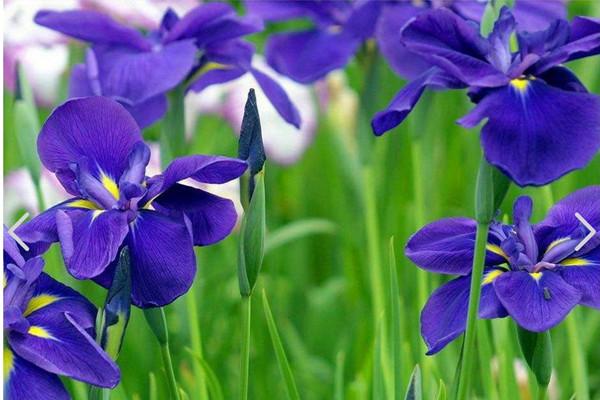
一、紫罗兰什么时候开花
和很多种的鲜花一样,紫罗兰春季开花,一般都是在4月到5月的时候。但是人工栽植的紫罗兰因为其播种时间的不确定性,花期也不定。通常来说,在温室内播种的紫罗兰首先要经历一个为期3到5个月的生长期之后才会开花,但是也有例外,受到气候因素影响,7月份播种的紫罗兰,需要等到来年的2月才会开花。
二、花期养护
1、光照
紫罗兰是一种比较喜欢冷凉环境的植株。但是紫罗兰不喜阴,如果环境过于荫蔽,会造成紫罗兰开花减少或者甚至不开花的现象,而光照过强,也会使它的叶片开始发黄,植株会干枯受损。
2、环境
紫罗兰虽然喜光照,不耐阴,但是其耐寒性比较好,而且尤其怕渍水。所以要注意将其放在较高的位置,这样能够更好的接触阳光,而且通风、排水也会比较好。 而且切记,紫罗兰最怕闷热,如果是在梅雨天气,炎热且不够通风的环境下容易遭受病虫害。

3、浇水
浇水对任何植株来说,首先来说就是要做好量的把控。紫罗兰浇水的时候不宜过多,因为水多会容易出现烂根,同时需要注意不能溅到叶片上,以免叶片腐烂。
4、修剪
在紫罗兰开花后,为了使其再次抽枝,需要对它的花枝进行适当的修剪。这样做的话,等到6、7月就可以2次开花了。
5、施肥
紫罗兰处于花期的时候,一定要减少施肥,因为此时施肥会使紫罗兰开花的时间变短。如果觉得必要的话,可以喷施一些花朵壮蒂灵,这样一来可以促使紫罗兰花蕾变得更加强壮、花瓣也会变得肥大、同时对紫罗兰的花色以及花香都是大有裨益的。
0
0
文章
家里的二哈爱吃花
2018年02月21日


病害之:黑斑病
发生这种病害,主要会表现在叶子上,发病的时间大约是3月至5月期间。发病时叶子表面会出现深色的斑点,这些小斑点会随着时间慢慢扩大,若不及时救治,整片叶子都会被这些斑点覆盖至掉落。
防治方法:发生病害时,可以用药用喷洒,阻碍它扩大。在临近病害发生时,可以先用药物进行预防。

病害之:炭疽病
此病害主要表现在叶子与枝茎上。发生病害时,叶子表面会出现黑色的斑点,发病时间大约是1月至5月期间。
防治方法:用药物进行喷洒。
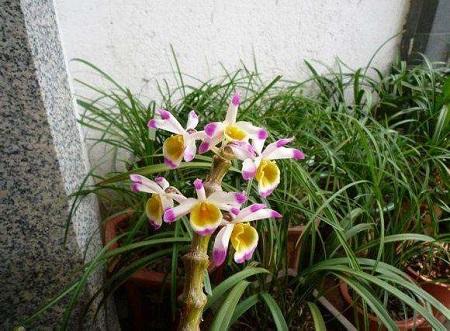
病害之:煤污病
病如期名,发生此病害时,整株植物的叶子都会被一层类似煤烟覆盖,从而使阳光无法与叶子直接接触,让植物无法在进行光合作用,也就导致植物无法正常生长。发病的主要时间是3月至5月期间。
防治方法:用药物进行喷洒。

虫害之:菲盾蚧
此虫害是以吸取植物的汁液生存的,若不及时防治,时间过长,整株植物都会因为水分的流失而死亡,有时还会造成其它病害。此虫害发生的时间是5月份开始。
防治方法:若发现较早,可以把虫害侵蚀过的枝叶全部剪除,较严重时就要用药物进行喷杀。
虫害之:蜗牛
引病害友友们应该常见了吧,很多蔬菜中都有它的身影。它主要是啃食植物来生存,而且没有固定的发生时间。最主要的是它的危害程度较大。
防治方法:可以下诱饵进行诱杀,同时还要用药物进行喷洒。日常养护时,一定要注意植株的干净整洁。
0
0




